Pei Pei Chen
Profiling Players with Engagement Predictions
Jul 09, 2019

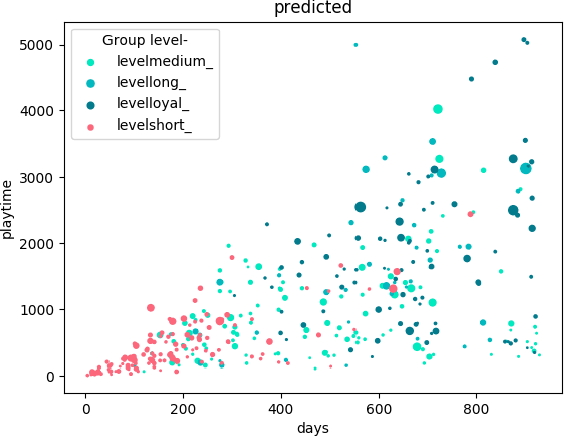

Abstract:The possibility of using player engagement predictions to profile high spending video game users is explored. In particular, individual-player survival curves in terms of days after first login, game level reached and accumulated playtime are used to classify players into different groups. Lifetime value predictions for each player---generated using a deep learning method based on long short-term memory---are also included in the analysis, and the relations between all these variables are thoroughly investigated. Our results suggest this constitutes a promising approach to user profiling.
From Non-Paying to Premium: Predicting User Conversion in Video Games with Ensemble Learning
Jul 01, 2019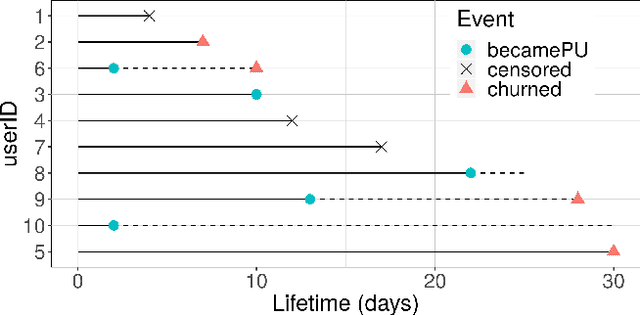

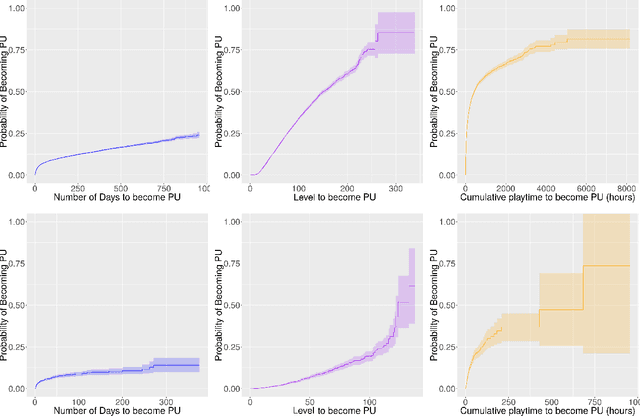
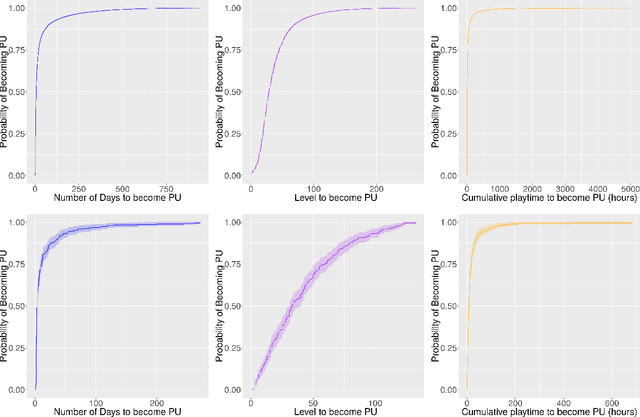
Abstract:Retaining premium players is key to the success of free-to-play games, but most of them do not start purchasing right after joining the game. By exploiting the exceptionally rich datasets recorded by modern video games--which provide information on the individual behavior of each and every player--survival analysis techniques can be used to predict what players are more likely to become paying (or even premium) users and when, both in terms of time and game level, the conversion will take place. Here we show that a traditional semi-parametric model (Cox regression), a random survival forest (RSF) technique and a method based on conditional inference survival ensembles all yield very promising results. However, the last approach has the advantage of being able to correct the inherent bias in RSF models by dividing the procedure into two steps: first selecting the best predictor to perform the splitting and then the best split point for that covariate. The proposed conditional inference survival ensembles method could be readily used in operational environments for early identification of premium players and the parts of the game that may prompt them to become paying users. Such knowledge would allow developers to induce their conversion and, more generally, to better understand the needs of their players and provide them with a personalized experience, thereby increasing their engagement and paving the way to higher monetization.
The Winning Solution to the IEEE CIG 2017 Game Data Mining Competition
Jan 16, 2019
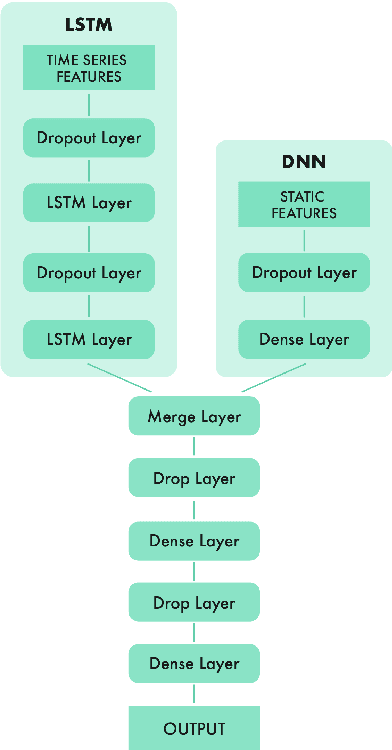

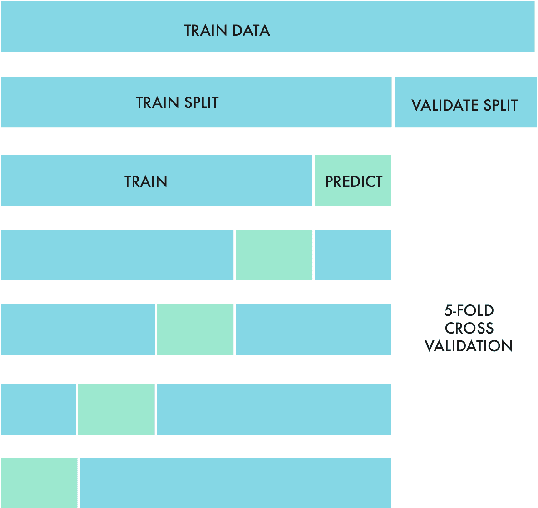
Abstract:Machine learning competitions such as those organized by Kaggle or KDD represent a useful benchmark for data science research. In this work, we present our winning solution to the Game Data Mining competition hosted at the 2017 IEEE Conference on Computational Intelligence and Games (CIG 2017). The contest consisted of two tracks, and participants (more than 250, belonging to both industry and academia) were to predict which players would stop playing the game, as well as their remaining lifetime. The data were provided by a major worldwide video game company, NCSoft, and came from their successful massively multiplayer online game Blade and Soul. Here, we describe the long short-term memory approach and conditional inference survival ensemble model that made us win both tracks of the contest, as well as the validation procedure that we followed in order to prevent overfitting. In particular, choosing a survival method able to deal with censored data was crucial to accurately predict the moment in which each player would leave the game, as censoring is inherent in churn. The selected models proved to be robust against evolving conditions---since there was a change in the business model of the game (from subscription-based to free-to-play) between the two sample datasets provided---and efficient in terms of time cost. Thanks to these features and also to their a ability to scale to large datasets, our models could be readily implemented in real business settings.
Customer Lifetime Value in Video Games Using Deep Learning and Parametric Models
Nov 28, 2018



Abstract:Nowadays, video game developers record every virtual action performed by their players. As each player can remain in the game for years, this results in an exceptionally rich dataset that can be used to understand and predict player behavior. In particular, this information may serve to identify the most valuable players and foresee the amount of money they will spend in in-app purchases during their lifetime. This is crucial in free-to-play games, where up to 50% of the revenue is generated by just around 2% of the players, the so-called whales. To address this challenge, we explore how deep neural networks can be used to predict customer lifetime value in video games, and compare their performance to parametric models such as Pareto/NBD. Our results suggest that convolutional neural network structures are the most efficient in predicting the economic value of individual players. They not only perform better in terms of accuracy, but also scale to big data and significantly reduce computational time, as they can work directly with raw sequential data and thus do not require any feature engineering process. This becomes important when datasets are very large, as is often the case with video game logs. Moreover, convolutional neural networks are particularly well suited to identify potential whales. Such an early identification is of paramount importance for business purposes, as it would allow developers to implement in-game actions aimed at retaining big spenders and maximizing their lifetime, which would ultimately translate into increased revenue.
A Machine-Learning Item Recommendation System for Video Games
Aug 14, 2018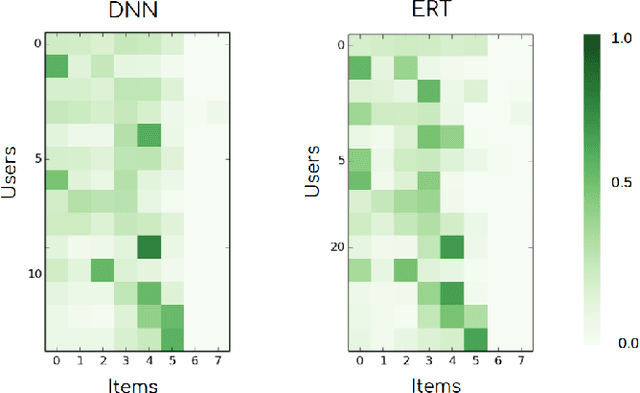
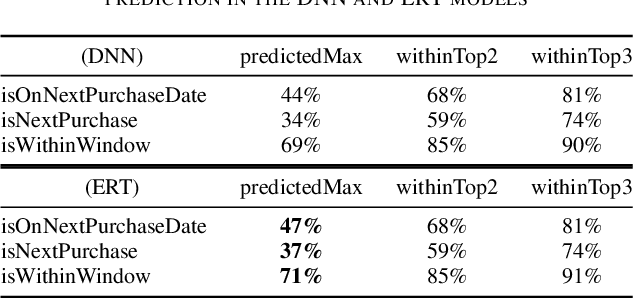
Abstract:Video-game players generate huge amounts of data, as everything they do within a game is recorded. In particular, among all the stored actions and behaviors, there is information on the in-game purchases of virtual products. Such information is of critical importance in modern free-to-play titles, where gamers can select or buy a profusion of items during the game in order to progress and fully enjoy their experience. To try to maximize these kind of purchases, one can use a recommendation system so as to present players with items that might be interesting for them. Such systems can better achieve their goal by employing machine learning algorithms that are able to predict the rating of an item or product by a particular user. In this paper we evaluate and compare two of these algorithms, an ensemble-based model (extremely randomized trees) and a deep neural network, both of which are promising candidates for operational video-game recommender engines. Item recommenders can help developers improve the game. But, more importantly, it should be possible to integrate them into the game, so that users automatically get personalized recommendations while playing. The presented models are not only able to meet this challenge, providing accurate predictions of the items that a particular player will find attractive, but also sufficiently fast and robust to be used in operational settings.
Forecasting Player Behavioral Data and Simulating in-Game Events
Oct 05, 2017
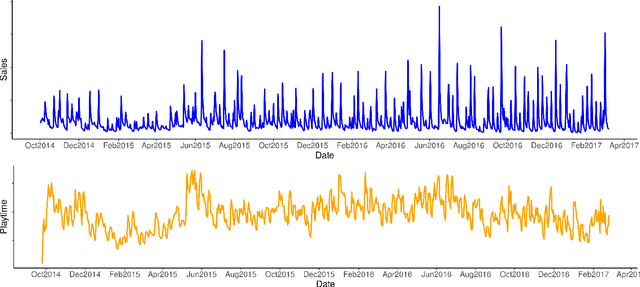


Abstract:Understanding player behavior is fundamental in game data science. Video games evolve as players interact with the game, so being able to foresee player experience would help to ensure a successful game development. In particular, game developers need to evaluate beforehand the impact of in-game events. Simulation optimization of these events is crucial to increase player engagement and maximize monetization. We present an experimental analysis of several methods to forecast game-related variables, with two main aims: to obtain accurate predictions of in-app purchases and playtime in an operational production environment, and to perform simulations of in-game events in order to maximize sales and playtime. Our ultimate purpose is to take a step towards the data-driven development of games. The results suggest that, even though the performance of traditional approaches such as ARIMA is still better, the outcomes of state-of-the-art techniques like deep learning are promising. Deep learning comes up as a well-suited general model that could be used to forecast a variety of time series with different dynamic behaviors.
 Add to Chrome
Add to Chrome Add to Firefox
Add to Firefox Add to Edge
Add to Edge